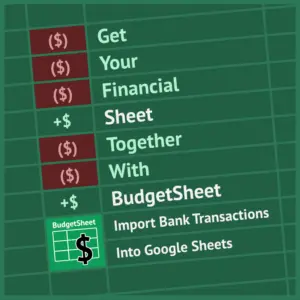* Some articles may contain affiliate links for researched products. There is no extra cost to you and it helps pay for boring stuff like website hosting and plugins.
LONG. TAIL. KEYWORDS.
What are these exactly? If you’re an Etsy seller trying to optimize your shop’s SEO, you would naturally have heard of the now-famous “long-tail keywords” – except maybe you’re not exactly sure what they really are OR how to use them in your SEO strategy. And that’s exactly what we’ll unpack and clarify together in this video. I also have a free Etsy SEO guide to help you out.
Let’s dive in (watch the video below or keep scrolling to read the text version).
PART 1 – WHAT ARE LONG TAIL KEYWORDS?
It’s probably best to start from the beginning and go over what the long-tail keywords really are.
As with everything Etsy SEO related, there’s a lot of confusion and misinformation out there.
Also, the fact that they are called “LONG” tail keywords is not helping because the truth is that how long a keyword is, is NOT what makes it a long-tail keyword. It’s related, yes, but the length of a keyword phrase or how many words it has in it is not what makes it long tail.
I know… kinda confusing. To understand what “long tail” means, take a look at this cute little graph I created for you:
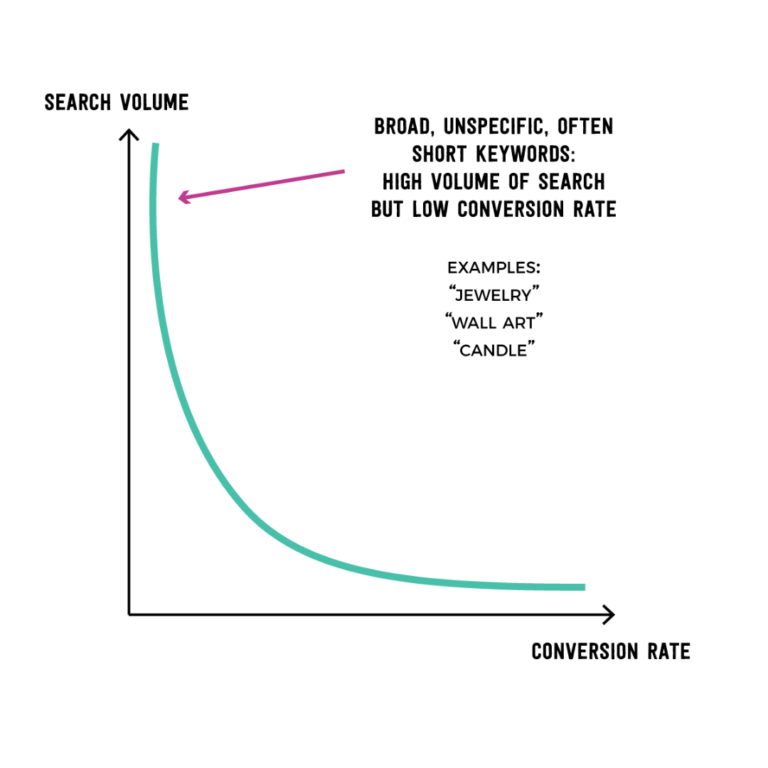
The horizontal axis represents the conversion rate for a given keyword (or how likely an item is to sell per 100 views when found using a particular keyword), and the vertical axis is the search volume (or how many people search for this keyword or phrase each month).
The green line is our keyword curve. At the top here, we’ve got broad – unspecific, often short keywords. These are keywords that have a high volume of search but a low conversion rate, meaning a lot of people search for it but they rarely purchase an item off the back of that direct search. These are the keywords like “jewelry” “wall art” or “candle”.
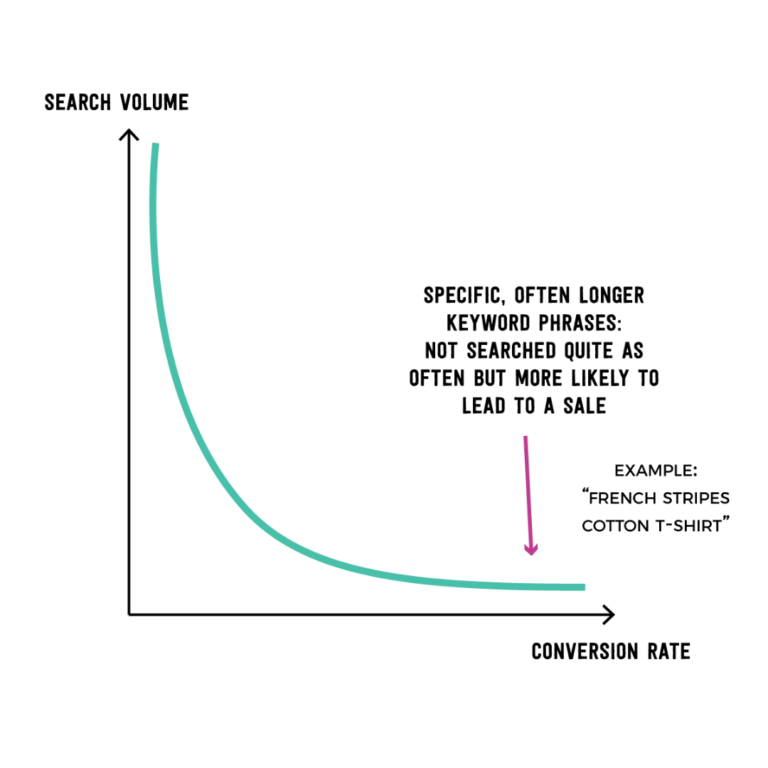
On the other side, right here at the bottom right, we’ve got specific, often longer keyword phrases: these are phrases and keywords that aren’t being searched for all that much but that, when they are, are much more likely to turn into a sale, for example,” french stripes cotton t-shirt”. It’s incredibly specific – chances are not many people type this into search every month, but when someone does they sure know what they want, and they are a lot more likely to turn into a customer.
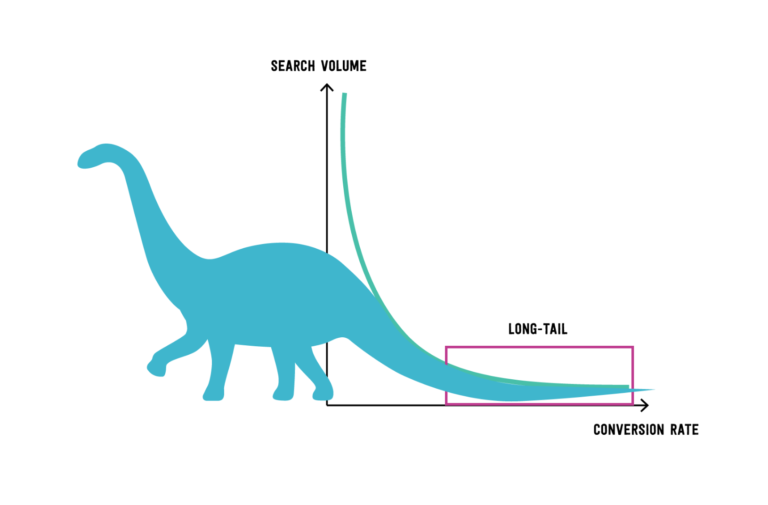
Now… here’s the important part: the section at the bottom of the curve are your long-tail keywords. Why? Because this section of the curve actually looks like a long tail. And yes, I am pretty happy with myself for managing to place a dinosaur in an Etsy SEO article.
But seriously, I hope this helps you remember that a long tail keyword is a specific search phrase with lower search volume but a higher conversion rate.
It is LIKELY to be a longer phrase, which is why a lot (too many if you ask me) of people out there oversimplify the definition by saying “long-tail keywords are phrases made of 3 or more keywords”.
Although it’s true that a phrase with 3 words is likely to be more specific than a simple one-word keyword, this is a dangerous generalization because what makes it long tail is the relation between the search volume and the conversion rate – not the fact that it has 3 or + words.
For example, “Gold wedding ring” is 3 words but it is NOT a long tail keyword, because it has a high volume of search and is not specific enough to lead to more conversions.
On the other hand, “recycled rose gold wedding ring” is a long tail keyword: not that many people search for it, but when they do, they’re likely to buy.
This is why sometimes Marmalead or eRank, if you’re using one of those, will tell you this is a long-tail keyword and it only has 2 words, and then tell you a 3-word phrase is not long-tail. It’s because they look at the volume of search and the engagement for each phrase, not how many words the phrase has.
OK, now that we know what a long tail keyword is, let’s keep going.
PART 2 – THINKING LIKE AN ETSY SHOPPER
The reason you want to focus on long-tail keywords, and the reason Etsy recommends you do so, is because doing so increases your chances at getting sales.
This is because of the Etsy’s shopper journey – which you MUST understand to create a good keyword strategy for your Etsy SEO titles and tags.
Most Etsy shoppers do NOT know what they are looking for. They might have a vague idea of what they want and who for, whether it’s for them, a gift for someone else, whether they want something to decorate their office or piece of clothing – but they don’t really know the specific when they start searching.
Because of this, they will naturally go on a journey from the top of this curve I showed you, to the long tail part of the curve:
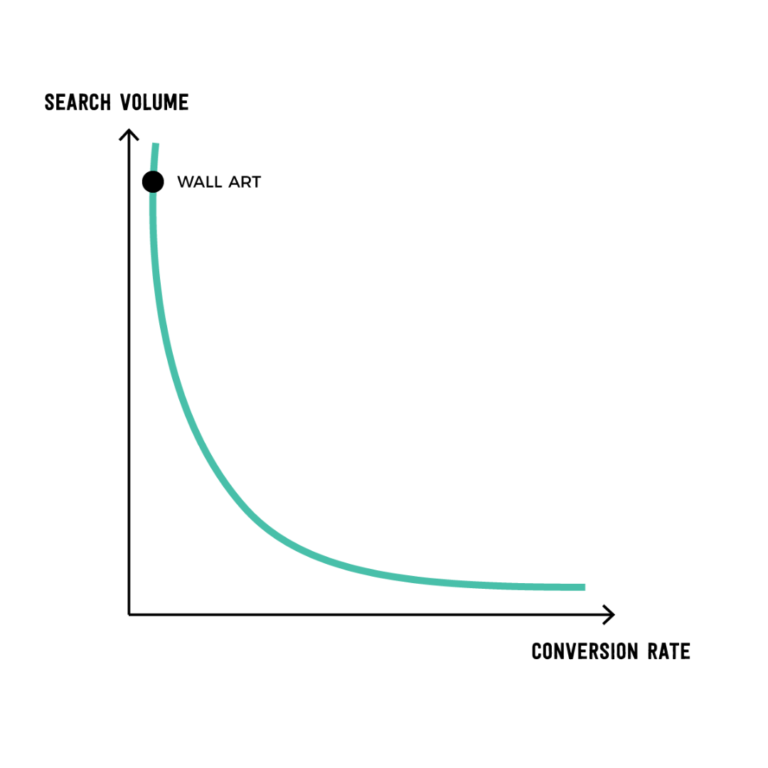
Let’s imagine someone just moved into a new apartment, and is looking to decorate their guest bedroom.
They might start with something as broad as “wall art.”
Etsy will show them a random assortment of “wall art” listings and this person is going to start realizing what she likes and doesn’t like. Maybe she’ll notice a lot of “abstract wall art” and realize she’s not all that into it. This forces her to ask herself “well, what am I into?” and maybe there’s this one floral painting there that she feels more attracted to.
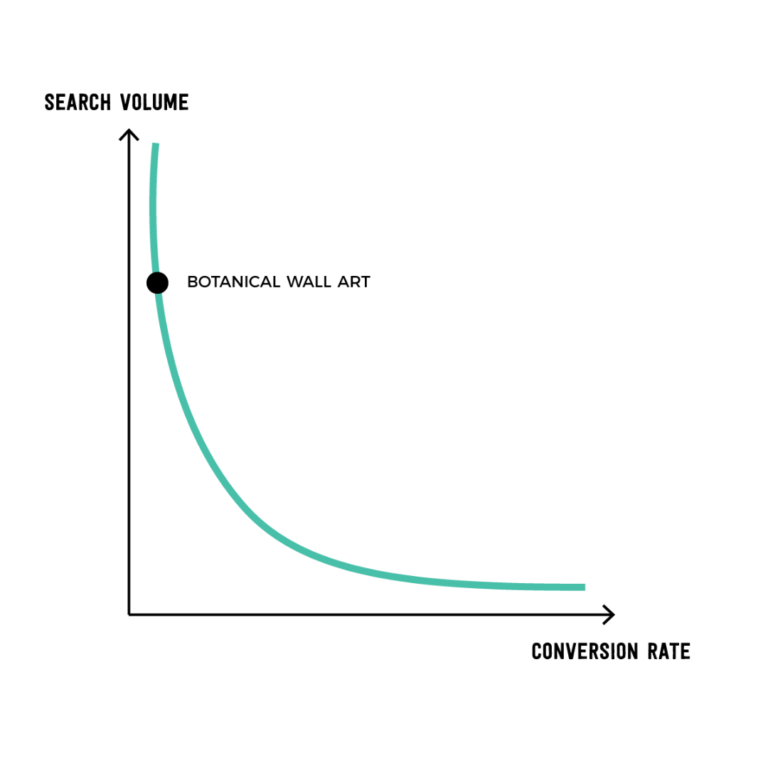
…so she goes back to the search bar and refines her search again, this time to “yellow flower wall art.”
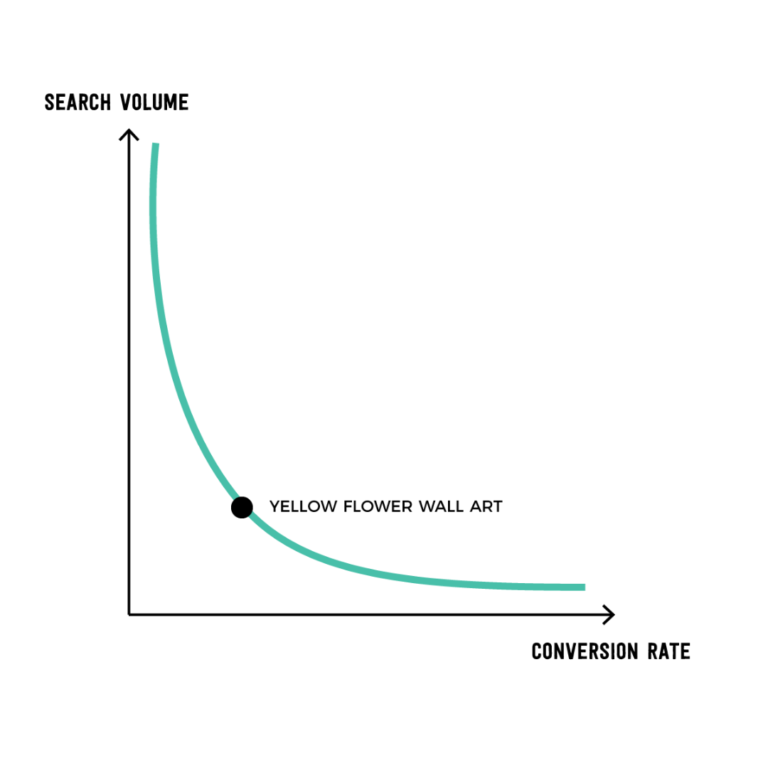
…and then even more as she notices some cool vintage-looking illustrations, to “vintage yellow flower wall art.” BOOM! Perfect, this is exactly what she wants – she makes a purchase.
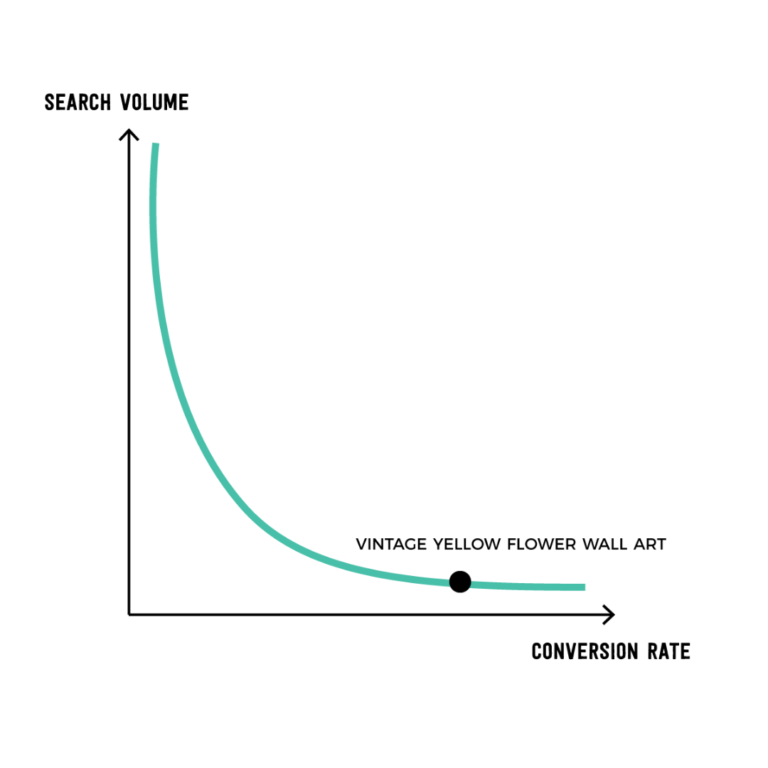
That my friend is an ETSY shopper’s journey or customer journey.
And that’s what you need to tap into when developing your keyword strategy which we’re going to do RIGHT NOW.
PART 3 – LONG TAIL KEYWORDS AND YOUR ETSY SEO STRATEGY
Let’s bring it ALL together. What does it mean for YOU and for your Etsy SEO strategy? How can you use long tail keywords to get more views and more sales?
And how are you meant to do that if your tags can’t be longer than 20 characters which for most long tail keywords is simply not long enough to fit?
To answer that, and to craft your Etsy SEO strategy around long-tail keywords, we need to define two more concepts which are relevancy and the difference between an exact search match and a broad search match. This is something I have previously explained in an article about Etsy titles and tags that you can read here, but for now what you need to know is that when someone types a keyword phrase in the Etsy search bar, Etsy uses many different data points to decide which listing will show first, second, etc in the list of results (commonly called ranking). One of these data points is what’s called RELEVANCY.
When a shopper types in keywords into the Etsy search bar, Etsy compares them to your titles, your tags, categories, and attributes.
The more closely they match what this shopper typed into the search bar, the more likely it is that your item will show up higher in the search results because it is more “relevant.”
Now, practically… what does this mean?
It means that your listing can match a shopper’s search EXACTLY or “BROADLY.”
Let’s look at an example:
Imagine your listing title is:
“Recycled Gold Ring, Engagement Band, Rose Gold Wedding Band.”
When someone types in “recycled gold ring” in search you have an EXACT match, because this exact phrase appears in your listing, with the words in this exact order.
This tells Etsy your listing is more relevant than someone else’s listing who does not have these exact words in this exact order.
On the other hand, if someone types in “recycled rose gold wedding ring” you will still show up in search, because “recycled” “rose” and “gold” and “wedding ring” are all keywords appearing in your listing, except this time it isn’t an EXACT match, but a “BROAD” match.
This means that if another shop has “recycled rose gold wedding ring” as an exact match in their listing that listing is, in the algorithm’s eyes, more “RELEVANT” than yours.
Of course you can’t hope to be an EXACT match for every keyword phrase you’d like to show up for because there’s simply not enough room in your tags and titles for this.
You also don’t want to repeat keywords unnecessarily between your titles and tags because that’s a missed opportunity to add more variety to your keyword strategy but YOU DO want to repeat in your tags and title the 1 or 2 keyword phrases that you most want to be “relevant” for – also commonly called “FOCUS KEYWORDS.
Which brings us to the question: should these “focus keywords” be long-tail keywords?
Given that Etsy said:
The first thought is YES, FOR SURE, let’s ‘exact match’ longtail keywords and make those my focus keywords, the ones I match in my tags so I ma real high on the RELEVANCY scorecard for those.
But sadly… that’s not necessarily true, and let me explain why with our favourite graph!
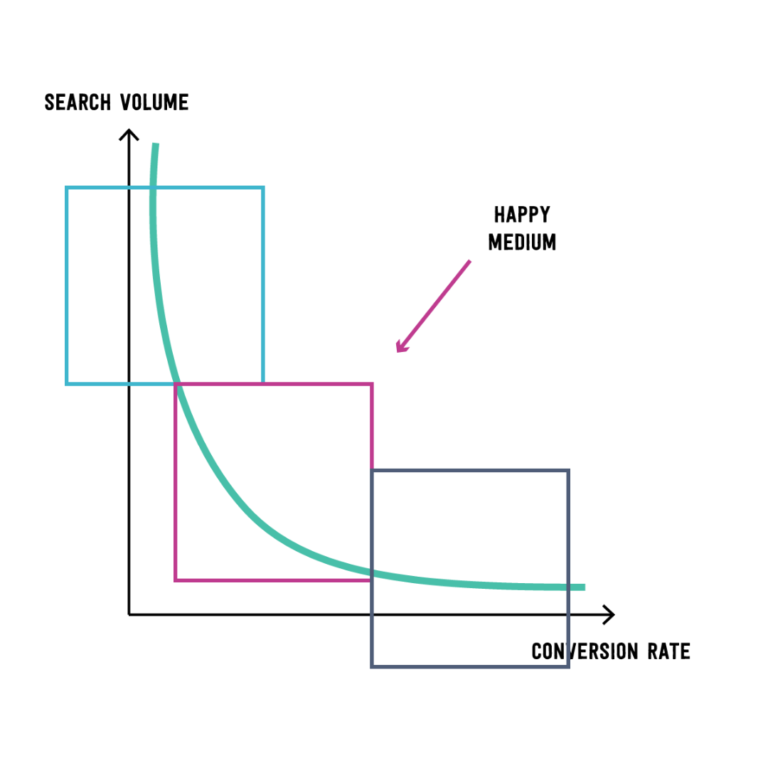
LET’S SUM UP WHAT WE KNOW SO FAR AND PROCEED BY ELIMINATION.
First let’s talk about our broad, not really specific keywords (blue box on the graph). We know it’s kind of pointless to focus exclusively on those broad, unspecific keywords like “silver jewelry” or “wall art” because even though a lot of people search for them, they don’t really lead directly to sales AND often the competition is also through the roof for those – so you’re unlikely to show up very high in the search results if you only focus on this – so trying to “exact match” for those is not necessarily your best bet.
OK then, what about our dear long-tail keywords (dark blue box on the graph) then? Should you make those your focus keywords? By definition, long-tail keywords are very specific and have less search volume, and for these reasons, they often also have a lot less competition – so you don’t necessarily NEED to make them your focus keywords to show up high in search.
For example, if we look at the search results for our previous example “vintage yellow flower wall art” – if I type this on Etsy I’m going to get just under 4000 results.
And if we scroll past the ads, we can take a look at what’s happening below. Some listings get pretty close to that search, but then we have some that really don’t and yet they are still super high in search, at the top of the 4,000 or so listings.
Why does this matter? Because it shows you that you do not need to have the full exact match for that long tail keyword in your title or tags to show up for them in search.
So, when thinking about long-tail keywords, rather than obsessing over being an exact match and trying to repeat them all between title and tags, you want to ask yourself instead: “can all your broader or slightly broader keyword (in your tags, attributes, categories, and title) be combined in a way that can help you for long-tail searches?”
With that in mind, you’re free to focus on what I like to call the happy medium. This is where your focus keywords, and as many keywords as you can should be. Not too broad, not too specific.
Remember, the broad, unspecific keywords are probably too competitive to be worth using as focus keywords, and they will naturally be in your listings, even if not as an exact match, because of your categories and attributes.
You can show up more easily for the “middle ones” without needing to exact match as we just saw, and so these ones are more likely to be where the gold is and worth your precious “focus keyword” space.
Something you must remember though: every niche and every shop is different. If something is working for you, keep doing it and PLEASE keep a close eye on your shop’s stats which hold YOUR truth and the key to YOUR best strategy. Some niches are small enough that even broader keywords might be worth competing for and trying to use as a focus keyword, there is no real one perfect formula here.
Also, different tools will define and categorize long-tail keywords differently, because they each calculate the ratio between engagement and search volume slightly differently. Both eRank and Marmalead for example might use a different algorithm to tell you if a keyword is long tail or not.
So don’t go trying to avoid using all long-tail keyword as focus keywords, or trying to only focus on exact matches for long-tail keywords – use common sense: you won’t get a perfect keyword with high search volume, high engagement, and low competition. Just remember that you want to be as close as possible to this “happy medium:” long-tail enough that this keyword is likely to lead to sales, but not sooo long tail that it’s way too specific and not worth using as an exact match.
WHAT ABOUT THE 20 CHARACTERS LIMIT IN ETSY TAGS?
“But Deb, you didn’t talk about the 20 character limit in the tags.”
RIGHT. I almost forgot this! Well, good news, you can absolutely split those!
If you want to use a tag “minimalist wood stud earrings” for your stud earrings, you can absolutely have two tags instead: one “minimalist wood” and one “stud earrings” and you’re all set – in fact I talk about Etsy tags and repeating them and matching them with titles and all that good stuff here, and I highly recommend you check it out.
Hope you learned a few things! 🙂




